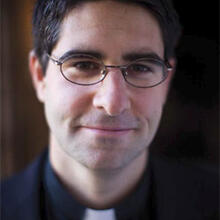The remains of William Henry Cardinal O'Connell, archbishop of Boston from 1907-1944, were removed from a mausoleum on the former archdiocesean property and reinterred in the courtyard of St. John's seminary last week. Boston.com reported yesterday [here] that a settlement had been reached between BC, the archdiocese of Boston and the descendants of Cardinal O'Connell who objected to the move. Leading the fight against both BC and Cardinal O'Malley was Paul G. Kirk, the Cardinal's grand-nephew. (Kirk was the Chairman of the John F. Kennedy Library when he was appointed to serve in the US senate upon the death of Ted Kennedy.) Cardinal O'Connell's bronze casket, weighing just under a ton, was moved from the Chapel of the Blessed Virgin to St. John's Seminary - most is which is now owned by Boston College after its sale in 2007 [There is an excellent article from Boston Magazine regarding the nature of the property and its sale to BC in 2008 - appropriately enough, it is entitled "Over His Dead Body"]. The Cardinal's new resting place is a five minute walk from the chapel.
Back in 2009, the Globe published the documents requesting the removal of O'Connell's remains [here]. BC wants to build a parking garage on the parcel of land abutting the Chapel of the Blessed Virgin. The Globe has also published O'Connell's will which is a fascinating document [here] detailing the disbursement of his personal wealth and the holdings of the archdiocese to his successor. In the will, O'Connell directs that his funeral "obsequies be as simple as possible," and that he "be buried in the Chapel of the Blessed Virgin on the grounds of the St. John's Seminary." The Cardinal's funeral in 1944 was a grand affair with several Boston Policemen lugging the bronze casket to the mausoleum. The burial befitted a man who grew the archdiocese from 250 parishes in 1907 to 323 at the time of his death. The man had unparalleled political power in Boston - see the Atlantic Monthly's review [here] of James M O'Toole's biography of the Cardinal, Militant and Triumphant: William Henry O'Connell and the Catholic Church in Boston, 1859-1944.
The removal of O'Connell's body is deeply symbolic. The man who secured the land and built the mansion in which Cardinal Law exiled himself in 2002, was simply picked up and moved as the situation around him changed so drastically. Philip Lawler's excellent book The Faithful Departed (2010) argues that it was O'Connell's tremendous success as an administrator that actually led to the episcopal mendacity that has so eroded the archdiocese since the reality of child sex abuse have come to light. About O'Connell, Lawler writes:
He had all the right arguments; he had all the right policies; he had all the right programs. There is no irony intended here; Catholicism really was flourishing in Boston, and O'Connell commanded respect even among non-Catholics. But like every successful administrator, the Cardinal was tempted to take his administrative process more seriously than his fundamental mission - in his case (as the old Christian addage puts it) to be so busy with the work of the Lord that he could forget the Lord of the work. (38)
Now O'Connell rests outside the one half of one building that the diocese has retained ownership of - St. John's Hall at St. John's Seminary - on the Brighton property that once housed the Lord of the work.








Morris says that when the Sulpicians left/pushed out of the seminary of St John's they had to take their buried dead with them. The adage that my kids used a lot years years ago 'What goes around comes around ' seems prescient in O'Connell's body being reburied.
http://www.sparknotes.com/poetry/browning/section4.rhtml